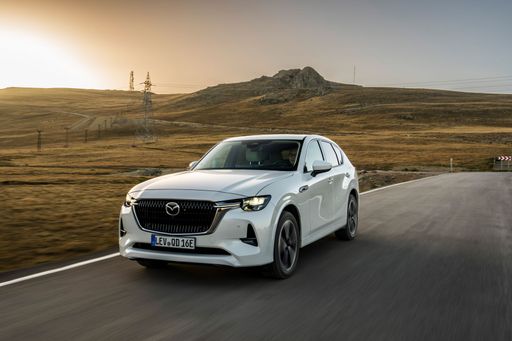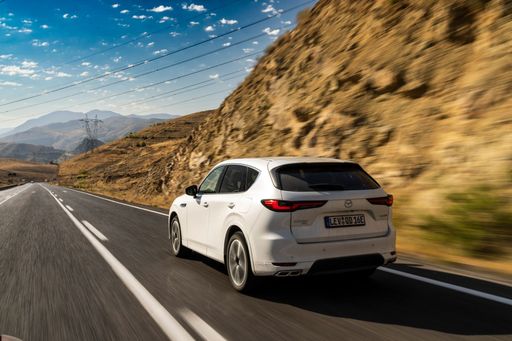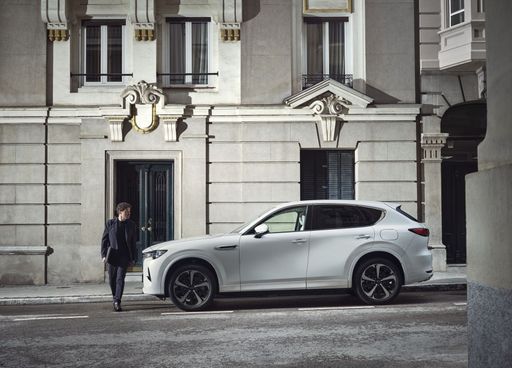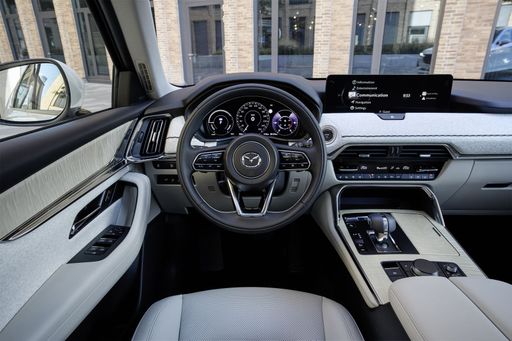Mazda CX-60 vs Nissan Interstar – Differences & prices compared
Compare performance, boot space, consumption and price in one view.
Find out now: which car is the better choice for you – Mazda CX-60 or Nissan Interstar?
The Mazda CX-60 (SUV) comes with a Plugin Hybrid or Diesel MHEV engine and Automatic transmission. In comparison, the Nissan Interstar (Cargo Van) features a Diesel or Electric engine with Manuel or Automatic transmission.
When it comes to boot capacity, the Mazda CX-60 offers 570 L, while the Nissan Interstar provides – depending on how much space you need. If you’re looking for more power, decide whether the 327 HP of the Mazda CX-60 or the 170 HP of the Nissan Interstar suits your needs better.
In terms of consumption, the values are 1.40 L per 100 km for the Mazda CX-60, and 7.40 L for the Nissan Interstar.
Price-wise, the Mazda CX-60 starts at 41900 £, while the Nissan Interstar is available from 34900 £. Compare all the details and find out which model fits your lifestyle best!
Mazda CX-60
The Mazda CX-60 exudes a sense of elegance and sophistication with its sleek design and refined styling. Inside, the cabin offers a harmonious blend of comfort and advanced technology, ensuring an enjoyable driving experience. On the road, the CX-60 delivers impressive performance and handling, making it a standout choice for those who appreciate driving dynamics.
details @ de.mazda-press.com
@ de.mazda-press.com
 @ de.mazda-press.com
@ de.mazda-press.com
 @ de.mazda-press.com
@ de.mazda-press.com
 @ de.mazda-press.com
@ de.mazda-press.com
Nissan Interstar
The Nissan Interstar is a versatile van that expertly combines practicality with modern design. It offers a spacious interior that caters to both cargo and passenger needs, making it ideal for businesses and families alike. With its robust performance and efficient fuel consumption, the Interstar stands out as a reliable choice in the commercial vehicle market.
details

|
|
|
|
|
Costs and Consumption |
|
|---|---|
|
Price
41900 - 56800 £
|
Price
34900 - 55600 £
|
|
Consumption L/100km
1.4 - 5.4 L
|
Consumption L/100km
7.4 - 7.5 L
|
|
Consumption kWh/100km
-
|
Consumption kWh/100km
-
|
|
Electric Range
64 km
|
Electric Range
175 - 410 km
|
|
Battery Capacity
-
|
Battery Capacity
-
|
|
co2
31 - 139 g/km
|
co2
0 - 195 g/km
|
|
Fuel tank capacity
50 - 58 L
|
Fuel tank capacity
80 L
|
Dimensions and Body |
|
|---|---|
|
Body Type
SUV
|
Body Type
Cargo Van
|
|
Seats
5
|
Seats
3 - 7
|
|
Doors
5
|
Doors
4
|
|
Curb weight
1890 - 2055 kg
|
Curb weight
2053 - 2535 kg
|
|
Trunk capacity
570 L
|
Trunk capacity
-
|
|
Length
4745 mm
|
Length
5680 - 6315 mm
|
|
Width
1890 mm
|
Width
2080 mm
|
|
Height
1680 - 1688 mm
|
Height
2498 - 2756 mm
|
|
Payload
581 - 612 kg
|
Payload
965 - 1447 kg
|
Engine and Performance |
|
|---|---|
|
Engine Type
Plugin Hybrid, Diesel MHEV
|
Engine Type
Diesel, Electric
|
|
Transmission
Automatic
|
Transmission
Manuel, Automatic
|
|
Transmission Detail
Automatic Gearbox
|
Transmission Detail
Manual Gearbox, Automatic Gearbox, Reduction Gearbox
|
|
Drive Type
All-Wheel Drive, Rear-Wheel Drive
|
Drive Type
Front-Wheel Drive
|
|
Power HP
200 - 327 HP
|
Power HP
105 - 170 HP
|
|
Acceleration 0-100km/h
5.8 - 8.4 s
|
Acceleration 0-100km/h
-
|
|
Max Speed
200 - 219 km/h
|
Max Speed
115 - 177 km/h
|
|
Torque
450 - 550 Nm
|
Torque
300 - 380 Nm
|
|
Number of Cylinders
4 - 6
|
Number of Cylinders
4
|
|
Power kW
147 - 241 kW
|
Power kW
77 - 125 kW
|
|
Engine capacity
2488 - 3283 cm3
|
Engine capacity
1997 cm3
|
General |
|
|---|---|
|
Model Year
2024
|
Model Year
2024 - 2025
|
|
CO2 Efficiency Class
B, D, E
|
CO2 Efficiency Class
G, A
|
|
Brand
Mazda
|
Brand
Nissan
|
Mazda CX-60
The Allure of the Mazda CX-60
Exploring the burgeoning SUV market, the Mazda CX-60 presents itself as a unique contender by combining sophisticated design, powerful performance, and pioneering technology. This British article delves into the detailed intricacies of the CX-60, providing an all-encompassing view of what makes this model stand out.
Engines That Lead the Class
The Mazda CX-60 comes equipped with a choice of pioneering engines including the Plug-in Hybrid and Diesel Mild-Hybrid. Whether you prefer the dynamic 327 PS earmarked with the Plug-in Hybrid or the reliable Diesel option delivering up to 254 PS, the range satisfies a diverse array of performance needs. These engines marry power with efficiency as evidenced by fuel consumptions ranging from as low as 1.4 L/100km to 5.4 L/100km—a remarkable feat in the SUV category.
Plug-In Hybrid: A Modern Marvel
The Plug-in Hybrid engine grabs attention with its e-Skyactiv technology, allowing for an electric range of 64 km, making short urban journeys effortlessly emission-free. Paired with an automatic all-wheel drive system, it provides swift acceleration from 0-100 km/h in just 5.8 seconds, while boasting a fuel efficiency that sets a new standard in hybrid innovation.
Diesel Option for the Road Warriors
For enthusiasts who crave longer journeys, the Diesel Mild-Hybrid variant stands steady. Available in both rear-wheel and all-wheel drive configurations, this engine combines an optimal balance of performance and economy. The most robust option, powered by a 3.3-litre six-cylinder formation, is engineered to deliver a smooth ride with a refined power output.
Interiors Crafted for Comfort
The Mazda CX-60 reveals an interior that speaks of luxury and meticulous craftsmanship. With seating for five, the cabin area is accentuated by options including the Takumi line, which couples elegant design with modern technology. Emphasising driver and passenger comfort, the seating materials and arrangement reflect Mazda's dedication to excellence and ergonomics.
Technological Triumphs
At the heart of Mazda's innovation, the CX-60 incorporates a series of technology enhancements aimed at elevating the driving experience. The inclusion of advanced safety features provides reassurance while cutting-edge infotainment systems ensure connectivity without compromising on design.
The Bottom Line
The Mazda CX-60, with a price range of €47,390 to €61,550, offers tremendous value for an SUV of its class. With a clever mix of technology, style, and performance, it becomes clear why this model is leading its segment. Its blend of dynamic powertrains, premium features, and innovative technology make it an enticing option for those in pursuit of a modern SUV.
Final Thoughts
With its captivating design and exemplary features, the Mazda CX-60 not only meets but exceeds the expectations of contemporary SUV enthusiasts. As Mazda continues to refine its vehicle lineup, the CX-60 stands as a testament to their commitment to creating vehicles that deliver both satisfaction and sustainability.
Nissan Interstar
The Evolution of the Nissan Interstar
The Nissan Interstar has long been a staple in the commercial vehicle sector, known for its robust build and practical design. The latest iterations have further cemented its status with a range of technical enhancements and innovative features aimed at aiding businesses in achieving optimal efficiency. Whether you're navigating city streets or traversing the highways, the Interstar stands out as a reliable workhorse ready to meet various transport needs.
Power and Performance
The current range of Nissan Interstar models boasts diesel engines ranging from 105 to 180 PS, offering a commendable blend of power and fuel efficiency across the board. With a fuel consumption of between 7.4 and 7.5 litres per 100 kilometres, these vehicles are designed to minimise operational costs while maximizing performance.
All models feature four-cylinder engines, with engine displacement between 1997 and 2299 cm³, capable of producing torque figures between 330 and 400 Nm. These specifications ensure that the Interstar offers superior pulling power, which is particularly useful for transporting heavy loads across different terrains.
Transmission and Drive Options
Versatility is at the heart of the Nissan Interstar, with transmission options including both manual and automatic gearboxes. Drivers can also choose between front-wheel and rear-wheel drive configurations, allowing the vehicle to suit specific logistical requirements or personal preferences.
For those seeking simplicity and ease of use in urban environments, the Interstar with its automated gearshift provides a smooth driving experience, reducing driver fatigue and increasing focus on the road ahead.
Dimensions and Load Capacities
The Nissan Interstar is available in various lengths, from 5048 mm to an extensive 6848 mm, catering to diverse commercial needs. With widths ranging from 2070 mm to 2222 mm and heights from 2307 mm to 2808 mm, the Interstar offers multiple configurations to maximise cargo space and accommodate various loads.
With a maximum payload capacity of up to 1451 kg, businesses can rest assured that the Interstar is more than capable of delivering goods efficiently without compromising on safety or comfort.
Innovation and Technological Features
While functionality remains a priority, Nissan has not skimped on technological advancements. Among the innovations included are advanced safety features, such as anti-lock braking systems (ABS), electronic stability control (ESC), and a variety of sensors to assist with parking and reversing.
In terms of driver comfort, the brand offers multiple trim levels with exceptional interior features designed to enhance driver experience during long hauls. Options such as climate control, advanced navigation systems, and modern infotainment setups are available, ensuring that both driver and passenger remain comfortable and connected, regardless of the journey length.
Coachwork and Trim Options
The Interstar line-up provides a range of trim levels and equipment lines, from the entry-level Visia to the high-spec Tekna, catering to different market demands and individual preferences. The selection allows buyers to prioritise features that best suit their operation or driving style.
For example, the N-CONNECTA variant offers an array of added extras, enhancing both connectivity and comfort for drivers who rely on the vehicle as a mobile office.
Conclusion
The Nissan Interstar represents a harmonious blend of power, efficiency, and technological innovation in the large van segment. With its vast array of options and features, the Interstar is undeniably a top choice for businesses looking to invest in a dependable and adaptable commercial vehicle. As the line-up continues to evolve, the Interstar remains poised to meet the growing challenges and demands of the modern logistic landscape.
The prices and data displayed are estimates based on German list prices and may vary by country. This information is not legally binding.
